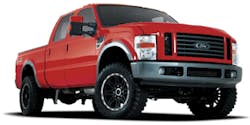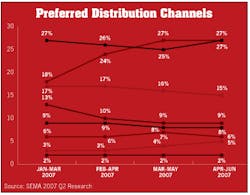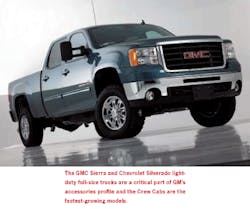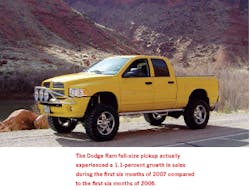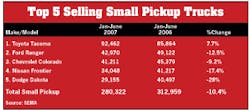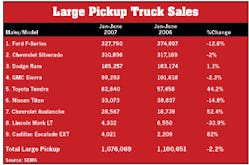Although light-truck sales are down, sales of their aftermarket parts and accessories—including lift kits, turbochargers, exhaust systems, suspensions, and larger wheels and tires—still thrive due in part to the off-road influence. As aftermarket trends evolve so do the technology and channels from which consumers purchase accessories. Dealerships realize there's money to be made in accessorizing and have been gradually stealing business from traditional aftermarket channels through promises of quality fit and finish of parts that won't void the vehicle's factory warranty. The convenience of purchasing a truck, having it modified at the dealer, and rolling the payment into the truck's financing makes it a one-stop shopping spree for consumers.
Let's take a look at the status of the light-truck market, where it's headed, and sales strategies from the perspectives of SEMA, truck manufacturers, and a few leading aftermarket suppliers/manufacturers.
SEMA's Take on Trucks
For the longest time automobiles outsold pickups but that all changed a few years ago. Products sold in the aftermarket industry now parallel new car and truck sales. "Our industry shifted when pickups started outselling cars. The aftermarket followed suit and companies that sold parts started to sell more SUV- and pickup-related styling and functional accessories. That has pretty much stayed true for
the past 10 years," said Peter MacGillivray, VP, communications and events for SEMA.
Pickups represent more than 50 percent of the parts sold in the aftermarket and more than 80 percent of truck owners modify their trucks at some point and to some degree; 50 percent of whom spend at least $2,000 on parts in the first year and 75 percent modify within the first 30 days of purchase, according to MacGillivray. Though states like Texas and Colorado own the truck market, MacGillivray believes more non-traditional truck owners have started to appreciate the utility of pickup trucks and the statement they make.
Although the media spotlight is on hybrids and alt-fuel vehicles, MacGillivray believes diesel is the biggest opportunity for the aftermarket in the short term because the technology and grade have changed. Gas price volatility doesn't bode well for pickups and at some point it may force consumers to shift toward more fuel-efficient vehicles. "However, as of now, the impact hasn't hit the enthusiast market we represent where their vehicle is at the center of their lifestyle, so they'll compromise on other things rather than the part of their life they enjoy the most," said MacGillivray.
Though full-size pickup sales dropped by 2.2 percent in the first six months of 2007 and compact pickups fell by 10 percent, SEMA projects U.S. demand for diesel engines and related aftermarket parts to increase 3.8 percent annually through 2011 to $20 billion. In fact, one in 10 new products introduced at the 2007 SEMA Show new product showcase was made for a diesel application. Modern diesels are gaining steam in part because they reduce emissions by 95 percent and improve fuel economy by 30 percent. Additionally, in 2007 diesel light-truck owners spent 17 percent more money on specialty equipment than non-diesel light-truck owners.
Considered the opinion leaders who push the technologies and trends that ultimately trickle down to the casual enthusiast, off roaders have a huge influence over the truck market. They play an important role because they're always pushing the limits in creating innovative solutions to new technologies.
A developing aftermarket trend is dealership modification, according to MacGillivray. "It's not a traditional business; a lot of dealers don't know what they're getting themselves into. We want to help them be successful because then the parts manufacturer wins, the retailer wins, the dealer wins, and the customer wins."
Truck Manufacturer Market Status
Despite its current weakness, the light-vehicle
market—including full-size trucks—is
still a growing segment because of the
various aftermarket components, including
street, racing, desert, off-road, and rock
crawling, according to Chris Mann, accessory
sales manager, Toyota.
"Pickup truck sales will rebound in the future because they are unique in that most people who own them are at least what we call 'occasional use imperative,' meaning there isn't a substitutable vehicle; they need a pickup truck," said Mann. "So while the construction industry may go up and down with the economy, when business picks up, there's no alternative vehicle, so the truck business will rebound along with it."
However, high gas prices may chase some buyer groups from the segment. For example, rather than customize full-size pickups, image buyers may elect to customize compact-size pickups or passenger cars. "But it's still an emotional segment; some may have an attachment to full-size pickups because of the identity they project, which will keep them loyal," said Mann.
The market directly reflects densely populated states including Texas, California, and Florida. Across the heartland from the Midwest to the Rockies are the highshare markets where a high percentage of the population drives pickup trucks. Cities that rank high in pickup truck ownership volume include Dallas/Ft. Worth, Houston, Denver, and Phoenix.
One of the most highly accessorized trucks in the market, Dodge Ram sales were down about 3 percent in 2007, said Rob Richard, marketing and sales director for Mopar. He attributed this to having the oldest pickup truck in the market and new launches from competitors. However, the primary reasons for sluggish sales trace right back to high interest rates, gas prices, and housing, which cause people to hold their vehicles longer. According to Richard, throughout the industry, pickup truck sales were down in 2007 by 4 percent versus the year prior.
"We see an economic rebound in light-truck sales. We also see manufacturers coming out with more fuel-efficient technology, whether it's diesel or hybrid," said Richard. Chrysler is currently working on more advanced stage-two hybrid technology with other manufacturers, which it will soon introduce in the Dodge Durango.
Light-duty full-size trucks are a critical part of GM's accessories portfolio, according to Tony Bedricky, marketing integration specialist, GM Accessories. "Our portfolio for pickups alone offers approximately 90 accessories. There is a movement toward a commuter truck for families, especially Crew Cabs, which are the fastest-growing models. There are the weekend warriors, who use trucks only on weekends and family haulers who use a truck as a commuter vehicle during the week."
Light trucks are the second-largest segment behind mid-size cars and GM will begin to offer more diesel powertrain options and hybrid pickups later in calendar years 2008-09. The Silverado and Sierra mild hybrids were discontinued in 2006 in favor of the new more advanced two-mode hybrid system available later this year.
Full-size trucks especially have struggled over the past few months, according to Scott Shirley, senior manager, model line marketing for Nissan. "It's too important for us and our competitors to not find the answer to slumping sales, whether it's due to fuel economy or high gas prices. There is a push for alternative fuels in general, but the answer probably hasn't been found yet on what we'll ultimately be doing in 10 or 15 years, so we're investigating lots of different options, including hybrid technology, diesel, and fuel cells."
Economic headwinds are challenging both individual consumers and fleets. "People use trucks to get work done and as long as the economy rebounds at some point, truck sales will likely follow that trend. It's interconnected with the economy," said Wes Sherwood, Ford Truck communications manager.
F-150 owners on average spend about $1,700 on parts, according to Sherwood. "The F-Series Super Duty diesel is popular and we have the new 6.4-liter twin-turbo PowerStroke clean diesel engine, so not only do you get the benefits of diesels, which offer a 25-30 percent fuel economy improvement, but they're now clean from an emissions standpoint."
Diesels are also much quieter and they no longer emit black smoke like they used to. Popular among customizers and tuners, the Super Duty lineup represents about 70 percent of Ford's sales.
Lowering is usually relegated to states with good weather year-round, including coastal regions and Texas, according to Mann. "There was a huge trend in the '80s and early '90s toward lowering, especially compact trucks, but it's largely disappeared, although there still is a trend toward lowering for performance. For more of a basic type of street modification, wheel and tire combinations are popular, even more so than a suspension or off-road package because usually the first thing somebody's going to do is put a larger diameter wheel and lower-profile tire on their truck."
A number of manufacturers are investigating building a light-duty diesel, which Mann believes will prove successful because of the demand for diesel given the price of gas and they are easily modified to produce more power. "It seems to be the trend at least in market perception that diesels will have the perfect compromise of performance and economy," said Mann.
For the 2008 model year, Toyota has increased its model lineup from 31 to 44. The 13 new models are "Tundra Grade," which hits a price point below the SR5. One of the advantages of Tundra Grade is to allow transaction prices less than $30,000 on extended cab trucks. In reintroducing itself to the full-size market with the new Tundra, Toyota is taking on new initiatives within the organization to support consumer preference toward truck customization.
"One of the things we've done is launch a truck customizing guide, which was our first attempt to combine popular genuine and aftermarket accessories in a point-of-sale catalogue used at dealerships. These are warranted by both the original manufacturer and our distribution company. We're expanding it in 2008 beyond Tundra and Tacoma into the SUV market," said Warren Victor, Toyota truck consultant.
For off-roaders, GM offers skid plates, brush guards, and lights. Appearance-based accessories include a new billet grille for the Silverado. "There's always the person who wants a really good-looking functional accessory for their work truck; for instance, we offer a cargo management system with bedrails in the back," said Bedricky.
Aftermarket wheels are popular because of their high visual impact. Front grilles and cargo bed capability are also priorities. "For the Titan, we introduced the first ever Utilitrack system, the only spray-in bedliner, and certain trim levels have bedside storage. So for OEMs, the trend is to get much more utility out of the box in the back," said Shirley.
Off-Road Initiative
Every major nameplate in the full-size truck segment offers an off-road version of their vehicle. The PRO-4X is the off-road version of the Nissan Titan. The market influences the products OEMs offer and how they're engineered. For instance, the PRO-4X is the only electronic locking rear differential in the full-size truck segment, so the R&D that goes into it is driven by the more demanding off-road consumer, according to Shirley.
The off-road influence led Mopar to launch its Trail Initiative to ensure it had the right presence, the right brand, and the right parts available, according to Richard. "At SEMA, we launched our Trail Initiative with our off-road truck used in the Baja 1000. We believe the next hot spot is what we call our 'trail' or 'off-road' vehicles with lift kits and larger wheels that meet the needs of our customers when they drive it on road and also give them the performance, parts, and accessories that enable them to go off road. People are looking to go a little more urban with their trucks. With off road, people customize their vehicles to look like SCORE trucks."
Rock crawling and desert racing also have shown explosive growth. The trend is to build the truck to either perform those functions or look like it can perform them. Off roaders tend to put a higher aspect ratio and more aggressive tread on their truck, according to Mann.
"If you look at a company such as Dealer Services International, which is part of the same company as 4 Wheel Parts, they have an exchange program whereby they pick up new vehicles from the dealer, bring them back to their facility, fit them up with wheels and tires, mild to wild lift kits, lights, etc.," said Victor. "But for the most part, they're limited to two or three packages; either street or off-road. Generally, those trucks don't stay on the lot long even though they command between a $4,000-$8,000 premium over the price of the truck. A lot of eyeballs are on the dealership to have one of those trucks parked in front and we can't keep the lift kits in stock because they're all going toward the vehicle upfits for the dealers. This presents a huge opportunity for dealers."
Toyota doesn't manufacture or endorse vehicle modifications other than those available through its corporate accessories department to ensure the vehicle meets its engineering specifications. "While we do not encourage dealers to modify vehicles prior to the sale, many dealers on their own have established relationships," said Rich Bame, national marketing manager, Toyota.
"Many full-size pickup buyers will actually have a shopping list made up before they even enter the dealership because they don't associate new-vehicle dealerships with the aftermarket customization style we're talking about with lifts and that kind of thing. So they'll already have an appointment scheduled for various things to be installed after they purchase the vehicle. We're making some steps to capture that business," said Mann.
Some consumers wrongly believe that simply accessorizing their truck may void its factory warranty. Toyota recently launched the 4.0-liter supercharger and is currently developing the 5.7-liter Tundra supercharger; neither affects the vehicle's warranty. "If somebody modifies a vehicle and that modification affects the way the vehicle performs, the rate at which other genuine parts on the vehicle wear or fail, or the ability of the safety systems inside the vehicle to function as engineered, those types of things wouldn't be warranted," said Mann.
Mopar invests a lot of time into developing parts that fit the vehicle properly, have the right attachment points, and pass Mopar's quality testing. A large segment of consumers who purchase vehicles want to buy parts from the dealer because they believe the original part meets OEM standards from a quality and fit standpoint and they can accessorize their truck at the dealership and roll it into their payment.
"People want to personalize their vehicle to meets their needs; it's form and function, customize and personalize," said Richard. "People may love a stock truck; they like the way it looks, they know it's going to be functional, they know it's going to meet their basic transportation needs, now the question they ask is what can you offer me to help me look different than the guy who's just buying the base truck?"
All GM parts and accessories are validated to the automaker's specifications and designed to integrate into the vehicle. "Our main focus is to continue offering a great-looking portfolio, but also ensure we continue executing a well integrated focus and our excellence in quality on those accessories to give the customers a sense of reassurance that it's been engineered and validated to the program's specifications," said Bedricky.
Aftermarket Supplier/Manufacturer Market Status
Bassani Xhaust has experienced a surge in light-truck accessory sales despite sluggish truck sales. A performance exhaust company based in Anaheim, California, Bassani specializes in Mustang, Corvette, and SRT-8 markets. "Truck accessory sales have improved this year because more truck people have found out we make performance," said Rick Brooks of Bassani Xhaust. "The benefits of our exhaust system are that it creates more horsepower, performance, and better gas mileage, so even though gas prices are higher, people are still doing things to their vehicles to improve mpg."
Modern diesel performance is taking off because they are significantly cleaner and many companies have done a lot of work in both Washington and across the U.S. to demonstrate just how clean and reliable diesels can be as seen in Europe, where more than 50 percent of the vehicles sold are diesel. It's only a matter of time before it starts to make inroads here in the U.S, according to Richelle Lyon, diesel market analyst, Honeywell-Garrett, a provider of turbocharging technologies based in Torrance, California.
Light trucks have always been Gibson Performance Exhaust's forte and they're constantly developing new products for them, particularly those featuring the new active fuel management and multispark displacement trucks to create better fuel economy, according to Shawn Gibson, VP of the Corona, California-based company.
Gibson believes light trucks will rebound in the future and the new hybrids coming out later this year may help spark sales. "There will always be a need for light trucks because there's a huge market for them. We all need a commuter work truck. They're going to come back harder than ever and will probably put a hurt on the heavy-duty trucks because of the fuel economy," said Gibson. "The only reason heavy trucks are kicking butt right now is because of the diesel. It's more cost-effective and supposedly more fuel-efficient. With Ford and Chevy coming out with smaller displacement diesels in a light-duty truck, I have a feeling it's going to kill the heavy-duty market."
The bottom line is that consumers today just don't have extra cash to supplement the increased price of fuel, which affects the automakers' ability to sell vehicles. Light trucks are still the vehicles of choice in the aftermarket, representing 50 percent of total purchases, according to Scott Poncher, president of ReadyLift located in Costa Mesa, California, which specializes in leveling and suspension.
Poncher believes the light-truck market should rebound if the price of gas and diesel subside. "It's too bad our government isn't addressing these issues. We've had alternative fuel technology for a long time and due to politics, that technology has been stifled because of the profits derived from the sale of petroleum and petroleum-based products."
Aftermarket Trends
As with most trends, a certain demographic exists for exhaust styles. In California, people like dual rear exit, meaning you get dual exit behind both back tires. In the Midwest and South, dual straight out the back is more popular. Bassani makes four exit styles to cater to different parts of the country.
"More new trucks come with nice tires and wheels, and while they used to be number one in aftermarket modifications, exhaust has picked up," said Brooks. "Not only can people make their truck unique by having the muscle car sound to it, but by changing the exit style it's differentiated from looking and sounding like a stock vehicle. From an exhaust standpoint, AftCats (from the catalytic converter back) is by far the most popular thing to do. For real performance-oriented consumers, they'll do headers all the way back, but that's a very small percentage of the market place."
It seems the big, crazy, over-the-top lifts and slammed deals are a thing of the past, according to Gibson. "One of the trends I've seen is a mild 2-inch lift and putting a 22-inch wheel on it. They're still doing the customized look, but consumers are going for the more conservative, cost-effective upgrades. The new Chevy 5.3 liters with active fuel management are the ones doing well right now."
Diesels are a huge part of the aftermarket because of the fuel economy and ease of performance upgrades, but that all changed in 2007 because of the emissions equipment and necessary CARB approvals diesels now have to meet. "You have big horsepower-improving components and fuel economy components and the manufacturers say they're going to void your warranty as soon as you modify anything," said Gibson.
Poncher also believes lifted and slammed trucks are fading as leveling kits are gaining popularity. "It's what the consumer wants; they want the nice tires and wheels. They don't want to spend thousands of dollars on a lift kit. They really just want their truck to sit level. People are always looking for something new and different and a lot of the traditional items like a tube step, fender flare, and billet grille are getting old and tired. It's a fashion business and like anything else, you've got to come up with new stuff."
On the contrary, Rize Industries, based in El Cajon, California, which specializes in custom bolt-on suspension lift kits and accessories, has seen increased demand for lifts, especially bigger kits, from 6 to 8 inches because enthusiasts now want 37-inch tires on their trucks. Gio Spanelli, manager of Rize, refers to the 37-inch tire as the new 35-inch tire. People are also switching from 20-inch wheels to 22- and 24-inch wheels. Diesels are gaining momentum over gas rigs because they have better towing capacity, fuel economy, power, and resale value.
Off-Road Influence
The off-road influence on the light-truck market sets a standard that is evident; however, differences vary by region. California trucks sit low in the back and are high in front because of the Baja influence and in Florida they're high in the rear. People not only want a lifted truck, they want it to be functional.
"With the different race series, more truck and off-road guys are going to these races to see what the trucks are doing, so it's a natural progression for them to want to modify their trucks and get more performance out of them," said Brooks.
Gibson estimates consumers between the ages of 16-29 make up the majority of the light-truck and off-road markets because they don't have a house payment and are living at home; they're not feeling the economy go down the toilet. They take their paychecks and put them toward creating a killer off-road truck.
Dealership Modifications
Although at least 2/3 of consumers still go to the aftermarket for parts, dealers are getting a lot more of the business than before because companies are providing them turnkey trucks so they can put them on their lots, said Poncher. Anyone can go online and find the same truck, but putting some added features differentiates it from a stock truck and provides the dealer a vehicle that can't be purchased anywhere else.
Rize sells lift kits to Ford dealerships and they actually install them and put wheels, tires, and exhaust kits on the truck before they sell it. "The accessories are rolled into the customer's payment, which may go up $100 but they've got $10,000 worth of accessories on there that didn't have to come out of pocket after the purchase," said Spanelli.
Bassani also pre-modifies vehicles with exhaust systems for dealers to help increase sales. "We have special programs for dealers who want to install one of our systems on their shop trucks to give customers incentive to put it on their vehicle," said Brooks.
With warranties becoming more stringent, some people feel more comfortable doing modifications through the dealers because consumers feel as if the dealer is almost forced to warrant their aftermarket exhaust. "There are people who won't even touch an aftermarket performance part until their truck's warranty is up. I do think factory warranties keep people from doing performance upgrades," said Gibson.
Sales Strategies
Strategies to continue increasing aftermarket parts sales include promoting fuel economy savings. Anything that can save fuel economy and the end consumer money in the long run is going to be an easy sell. Gibson suggests putting together packages instead of selling just one component, like an air filter or an exhaust—something that's going to provide a hard-core improvement.
"That's the cool thing about being an aftermarket performance parts dealer is you can put together your own packages and make yourself unique from someone else by testing out certain products to find out what works for your application," said Gibson. "Instead of pushing one product, put all the products together that have worked best for you and now not only are you making points off just one product, you're making points across the board on many different products."
Spanelli suggests frequently offering new and innovative products to keep the customer interested. Don't expect to keep selling the same old thing. "It's a transition to the new trends. One thing I learned is people are keeping their trucks a lot longer (seven years) than they normally would since they're spending so much money on them."
Connecting with the consumer on a personal level is also a valuable skill and answering questions to support the customer after the sale will keep them loyal. "That's why we've set up our PowerMax Authorized Distribution (PMAD) network," said Tracie Parker, sales and marketing manager for Garrett. "Our expectation is not only will they sell the turbo, but they can also install it and service it in the future and provide pointers to the user on how they can maximize power and performance of their truck. You have to provide not just the product but the service that goes beyond the sale."
Stay aggressive, even when times are tough, Poncher suggests. Find new ways to attract the customer to your store. Be creative and realistic about what you can do. People are looking for a deal. To get a consumer to be loyal to your business, offer rewards. Capturing somebody on one purchase may result in incremental business.
